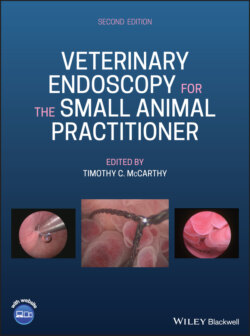Читать книгу Veterinary Endoscopy for the Small Animal Practitioner - Группа авторов - Страница 32
2.2.8 Operating Tables
ОглавлениеStandard veterinary operating tables are usable for many endoscopic procedures but specialized tables allowing patients to be tilted from end to end in both directions and from side to side in both directions are a great asset. Cystoscopy, rhinoscopy, otoscopy, laceroscopy, fistuloscopy, oncoscopy, oculoscopy, and analsacoscopy are performed on a flat horizontally positioned table. Laparoscopy and thoracoscopy require tilting tables. Some simple abdominal and thoracic procedures are performed on a flat table by repositioning the patient under the drapes, but this is cumbersome and is inadequate in many situations. Using a standard surgical table that is manually tilted end to end in one direction will work but planning ahead is critical to make sure that the tilt of the table is aligned with the direction needed for the planned procedure. If the patient is positioned in the wrong direction, it is extremely difficult to be corrected after draping. Securing the patient to the table is also very important so that the patient does not slide off the table when it is tilted. Some newer surgery tables are tiltable end to end in both directions. A table of this kind is desirable for minimally invasive surgery.
A manual table that tilts side to side specifically designed for small animal minimally invasive surgery is available that attaches to the top of most currently available small animal surgery tables and works well as an inexpensive alternative (Figure 2.20). Using this table, patients can be tilted 45° to each side with an intermediate tilt position (Figure 2.21). This table is more than adequate for the general practice setting primarily interested in performing laparoscopic ovariectomies (Figure 2.22).
Figure 2.20 A manual Tankersley tilt table (TTT) designed for performing laparoscopic ovariectomies in dogs and cats. This table attaches to the top of most standard‐sized small animal surgery tables.
Figure 2.21 The Tankersley table tilted 45° in the position used for laparoscopic ovariectomies. The table tilts to both sides and has an intermediate tilt position for use when less angulation is required.
Figure 2.22 A large dog fixed in place on the TTT ready for performing a laparoscopic ovariectomy. The Tankersley tilt table is currently available through Karl Storz.
For the specialty practice planning to advance into complex minimally invasive abdominal and thoracic surgery, a powered operating table with four‐way tilt capability is a needed addition (Figure 2.23). This table is controlled with a joystick that is accessible and operable through drape material allowing the surgeon to position the patient during surgery and to change positions as needed. The table tilts 45° to the side in both directions (Figures 2.24 and 2.25) and 15° head to tail in both directions (Figure 2.23).
Figure 2.23 A DRE Panomed operating table for small animal use shown with the patient tilted both in a head down position and tilted slightly to the right. The black pads on both ends of the patient and on both sides are positioners to hold the patient in position when the table is tilted to the side. The DRE Panomed table is available through DRE Veterinary (http://dremed.com) that has changed its name to Avante Medical Surgical (http://avantehs.com/medical).
Figure 2.24 The DRE Panomed powered operating table for small animal practice with the patient tilted 45° to the left. Note the positioners on both sides of the patient. For a dog of this size when 45° tilting is planned, four of the positioners are needed, one on each side for the thorax and one on each side for the abdomen. Prior to draping, tilting is done to each side to test for patient stability and confirm that the patient will not slide off the table when the table is tilted.
Figure 2.25 The same patient as seen in the Figure 2.24 tilted to the right prior to draping completing testing for patient stability. This is easy and quick and can minimize the risk of a disaster.
